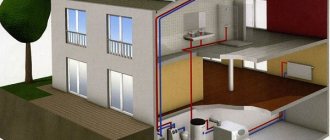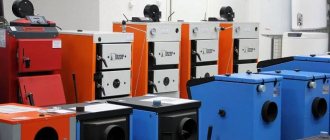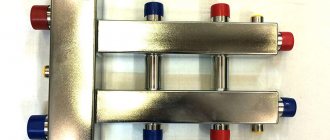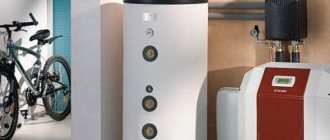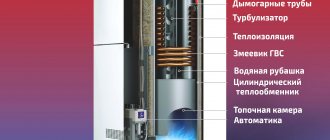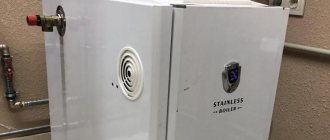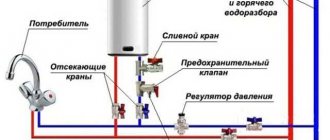The use of electrical energy for heating has many advantages. So, if we compare such a system with gas heating, it is worth noting that electricity is available in every home. An electric boiler does not require a permit; such boilers are small and their price is lower. Of course, the cost of electricity may completely offset the benefits for some users. But currently, developments are aimed at increasing the efficiency of boilers and reducing heat losses. And the most promising system in this case is inverter heating boilers.
Inverter heating boiler
What are inverters for a heating boiler and why are they needed?
An inverter is a converter of direct current into alternating current with a change in voltage. It is powered by a built-in or external battery with a voltage of 12, 24 or 48 V and generates an output voltage of 220 V, typical of a standard single-phase household electrical network. Modern inverters for heating boilers also produce a stable sine wave with a frequency of 50 Hz, which is precisely the frequency required for the operation of volatile boilers.
An example of an installed and connected inverter with two external batteries (12 V) in a boiler room with a gas boiler and a buffer tank.
Although equipment is not mandatory, its importance is often underestimated. An inverter is needed to:
- automatically, without interruption in operation, provide normal power to any volatile boiler in the event of a power outage;
- restore normal voltage of 220 V in the event of a drop in network voltage below the critical level required for boiler operation;
- prevent freezing of the heating system and its damage due to the boiler being turned off (if antifreeze is not used as a coolant);
- prevent failure of boiler components due to a voltage surge or drop, most often this is an electronic control board (automation). Expensive boilers with complex automation, such as Viessmann, Vaillant, Lamborgini, Ferroli, are especially vulnerable, but this also applies to Russian-made boilers, for example, volatile Lemax models. In this case, the inverter will turn off external power from the mains and provide normal electric current characteristics for a certain time.
Many manufacturers equip modern inverter models with additional modules: charger, controller, etc. This erases many differences from UPSs (uninterruptible power supplies that have broader functionality) and causes confusion. Depending on the model, a modern inverter may have even more functionality than a UPS, although in its classic form, a voltage converter is only one of the elements of an uninterruptible power supply.
Therefore, the choice between devices is ambiguous; we recommend that you always compare not the difference between devices as a whole, but the capabilities and cost of a specific converter model with the capabilities and cost of a specific uninterruptible power supply model.
But in general, the main thing is to know that the simplest inverter provides longer power (from 2-4 hours or more) than the simplest UPS (from 20 to 30 minutes). At the same time, the cost of a budget converter, even taking into account the purchase of a battery, is on average 2 times lower than the cost of a budget uninterruptible power supply.
Why is it needed for a gas boiler?
If you do not focus on energy independence, then a fully functional modern gas boiler requires a connection to the electrical network to power a control board with a controller, a circulation pump and a group of control units that can be distributed throughout the house. Such a set of equipment allows you to completely and accurately control the heating of the house, raising the heating to a higher level, ensuring high comfort of life in the house. If this is the case, then when the power goes out, the heating, unfortunately, stops completely.
In order not to be left without heating, you should provide in advance a backup power source for the gas boiler and all auxiliary equipment. Options include: gas or diesel (gasoline) generator, uninterruptible power supply (UPS) or inverter.
Installing a generator requires large capital investments, which is why UPSs and inverters have become more widespread. In them, electricity is stored for future use in batteries and, if necessary, given to the load, the boiler. More often than not, if the electricity goes out, it’s not for long, so the energy stored in the batteries is quite enough to keep the boiler from stopping and the coolant from cooling down.
The main requirement for any backup power source for a gas boiler is a stable sinusoid and output voltage amplitude. The gas boiler does not have any converters or stabilizers of its own, so any surges or deviations will affect the quality of the controller and sensor readings. The shape of the sine wave is critical for the circulation pump. The more regular the sinusoid shape, the more stable the current frequency. The better the pump works.
Household and computer UPSs produce a signal only partially similar to a sine wave, more like alternating rectangular pulses. For the intended purposes, this is enough; computer and office equipment have their own power supplies that convert the input voltage.
Putting all of the above together, it becomes clear why uninterruptible power supply units and inverters for heating boilers are designed and manufactured separately and with increased requirements for the characteristics of the output signal.
Design and principle of operation
The principle of operation of the inverter as a separate element is quite simple. To provide power to a consumer (boiler) operating on alternating voltage, by connecting a direct current source (battery), you must first connect the source with one polarity, then disconnect and connect it with the reverse polarity. Accordingly, in order to obtain the required frequency of 50 Hz, it is necessary to carry out the switching algorithm 50 times per second, which is what modern inverters do.
The switching functions are performed by an electronic board with a set of transistors or tristors operating in switching mode. Converters with a power of over 300 Watt emit a large amount of thermal energy during such operation, therefore they are additionally equipped with a cooling system.
A diagram showing the operating principle of a voltage inverter.
Let's look at the principle of operation of the inverter using the example of the schematic diagram above. On the left is a UA with terminals 1 - 2 and an RHLH1 active-inductive boiler with terminals 3 - 4 . At time I , the boiler is connected with terminals 3 - 4 to terminals 1 - 2 UA , and the current direction is from UA to LHRH1 . At the next moment of time II, terminals 3 - 4 change their position and the direction of the current changes to the opposite relative to the boiler - the consumer of electrical energy.
Why should you buy an electric boiler?
There are many options for heating your home.
The choice depends on the availability of a particular resource and conditions of use. So the gas main may be located away from a private building. In this case, you will not be able to connect gas equipment. Heat generators operating on solid or liquid fuels require special conditions. To store raw materials you need to allocate a specific place. In addition, constant monitoring of the operation of the unit is required. In this regard, the 220 electric boiler is more practical and easier to maintain. Its installation is quite simple, the device works stably and does not take up much space. Of course, the cost of electricity is constantly rising. But this does not reduce the popularity of units of this type. Moreover, today there are energy-saving models.
Many owners of suburban areas prefer boilers powered by electricity.
Some models of these units can provide the room not only with heat, but also with hot water. In city apartments, electric boilers are sometimes also installed. It should be noted that an electric sauna boiler can also be successfully used. There are devices that can be controlled remotely. This way you can turn on the boiler while still on the road, so that upon arrival the bathhouse will already be sufficiently warmed up. Therefore, in many cases, electric heaters are an excellent alternative to other types of heat generators.
Simple and accessible information about the types of voltage converters
The type of inverter is the main criterion when choosing, which you need to decide on first. Each type has certain properties, operating algorithm and characteristics.
Off-line
Off-line inverters are also called backup inverters; they have the simplest design and operating algorithm:
- At normal voltage in the electrical network, the inverter is inactive, and the boiler operates in normal mode, exclusively from the electrical network.
- As soon as the voltage in the electrical network drops below a critical level (usually 175-190 V) or disappears altogether, the inverter instantly switches the power to the boiler to the battery connected to the converter. The switching occurs imperceptibly, in modern models it takes 4-8 ms, which is enough for the uninterrupted operation of the boiler unit.
- As soon as the voltage in the electrical network is restored, the inverter switches power to the main network and goes into standby mode.
We recommend: Foil insulation: varieties, properties and possibilities of use
Also, most devices are designed for overvoltage; they usually operate at values above 260-300 V. Off-line inverters are the simplest and most inexpensive, their prices start from 4 thousand rubles.
However, it is better not to use them if the power supply voltage fluctuates too often or constantly. With such instability, the converter switches from the main power source to the backup one too often, which leads to very rapid wear of the batteries.
Line-interactive
Line-interactive voltage converters are the most optimal and universal for a modern heating boiler. In addition to the converter and switching relay, as in Off-line devices, linear-interactive models use a voltage stabilizer.
In standard mode, the boiler still consumes electricity from the main network, but the voltage is equalized by a built-in stabilizer; some more technologically advanced models are equipped with additional filters that smooth out noise, eliminate interference in the network, etc. With this type of operation, the battery is used less frequently and the energy efficiency (efficiency) is much higher.
Linear-interactive models often have a built-in battery that can ensure the boiler operates for 20-120 minutes, while it is also possible to connect external additional batteries that can extend autonomy to several days.
A Line-interactive inverter will always be sufficient for any gas, solid fuel or low-power electric boiler. However, such equipment also has disadvantages - poor smoothing of the sinusoid during interference, disruption of its uniformity during deep drawdowns or drops (switching time of 4-6 ms does not protect overly sensitive modules).
On-line
The most technologically advanced and expensive double conversion inverters. A simplified operating algorithm looks like this:
- At the input, the inverter converts the alternating voltage of the electrical network into a constant voltage of 12 V.
- At the output, the inverter converts 12 V to 220 V with a perfectly pure sine wave with a frequency of 50 Hz.
The batteries in such a device act as a buffer capacity necessary to equalize the current parameters. The advantage of the technology is that the boiler does not contact the electrical network directly and, at any current parameters in the network, receives an ideal, pure sine wave produced by the inverter. However, due to double conversion, the efficiency of such equipment is lower, up to 90%.
Types of inverter heater
The devices can operate on liquefied gas and are suitable for country houses.
The inverter is capable of changing the characteristics of the heater if the latter is electronically controlled. The actual design of the heater does not matter. But since the technology is expensive, the unit is installed on high-end models.
By type of fastening
These units can be floor-mounted, wall-mounted or baseboard-mounted.
- Floor-standing ones are distinguished by the presence of wheels, which allows you to transport the unit from one room to another. This suggests that floor-standing options are mobile. For example, when heating one room, you can then warm up another. And given the low power consumption, this device has even more advantages.
- Wall-mounted devices are mounted on vertical surfaces. Less mobile than floor or baseboard ones.
- Due to their special structure, baseboard They have the principle of operation of a water baseboard, when the entire area is heated at once. Another advantage is that the presence of any cold places is suppressed by the heat created, various changes in the room temperature are prevented, and rooms do not fog up. This type of equipment can also be easily moved and transported, just like floor-mounted equipment.
By type of heating element
Presented in 3 types:
- electric;
- gas;
- energy saving.
Electric ones operate from the mains. Such devices are popular among those who purchase them for an apartment.
Gas models operate using gas. The main function is to maintain heat in small areas or even in some unheated rooms. The advantage is that with low fuel costs, the device effectively heats the entire room.
Ergonomics, simplicity and high mobility make them an ideal option for their price.
Energy saving is suitable for those people who do not have a particularly powerful electrical system. Considering the increased efficiency (compared to other equipment of this type), this feature makes this type of equipment even more preferable. If you look at statistical calculations, you can see that the total amount of electricity saved is up to 60%. Very serious numbers, especially with high efficiency.
Also, the elements themselves can be of different types.
- A heating element in the form of a tape or needle. The loops are located on the sides of the plate, and these loops are frangible. Due to the fact that the design does not include fins, the air heats up rather slowly. Nowadays it is rare to find such equipment, since it has not been produced for a long time.
- A heating element (tubular electric heater) can also heat. The tube consists of ribs. The greater their number, the more heat the room will receive. The heating element can heat up to a high temperature, so the efficiency of this device is higher than that of a tape or needle.
- The monolithic type has a special design. The nichrome thread is housed in a ribbed housing made of aluminum. Thanks to this, the likelihood of losing heat is extremely low. Low noise level.
Gas
Such heaters operate on natural or liquefied gas. Since it is a cheap fuel, heating a room costs only slightly more than using hydronic heating. It is designed for heating large areas and is perfect for a summer residence.
Inverter technology increases the efficiency of the device. The burning intensity of the burner changes smoothly, which eliminates the risk of extinguishing the flame. Fuel is consumed even more economically. Inverter units are more compact than conventional gas heaters.
Infrared
The principle of IR heaters is to heat objects in the room, which will then emit heat.
Heating elements emit infrared radiation - this is a plus. In this case, it is not the air in the room that heats up, but surfaces, objects and people. This makes it possible to provide comfort at an actually lower temperature.
We recommend: Warm water floor
The heater works the same way as the others: it turns on when the temperature drops and turns off when it rises. An inverter electric infrared heater works without switching off, only reducing the heating intensity. The device consumes much less electricity with high heat transfer. This is important because electricity is expensive.
With heat pumps
This refers to air conditioners that can operate in reverse mode - not only for cooling, but also for heating. The fan blows cold air from the outside, but since the temperature of the refrigerant is still much lower, the latter boils and condenses at the compression stage, releasing heat. The heat is transferred to the air in the room through the heat exchanger. Thus, an air conditioner with a heat pump receives heat from air with a temperature of up to 0 C.
Such a system turns out to be cheaper than an electric heater. An inverter unit makes the air conditioner even more economical. When the desired temperature is reached, it does not completely turn off the installation, but switches it to minimum power mode. Without peak loads, the device operates longer and consumes less electricity.
Convectors
The inverter operating circuit has been introduced into convection-type heaters.
An inverter is also installed in electric convectors. Such models are presented by Electrolux and Bally. The principle is the same: the unit does not turn off the device, but reduces the power. The heater operates in maintenance mode most of the time. At the same time, it consumes less electricity and wears out less.
In this mode, heating elements heat up to a lesser extent and less oxygen is burned. Inverter convectors are safer for health.
Equipment Features
An inverter boiler, like every type of heating device, has its advantages. Thanks to this, the equipment is quite popular among consumers and is gradually being used more and more often. At the same time, of course, one cannot do without disadvantages, although for such boilers they are not very significant.
Advantages and disadvantages of inverter heating
Inverters, in a broad sense, are devices that convert direct current into alternating current, and their operating principle is based on the phenomenon of electromagnetic induction. How does inverter heating differ from other types of heating systems? The list of differences is quite impressive:
- The design of inverter boilers has no moving parts or mechanisms, so the wear resistance of such devices is higher. Thus, the service life of inverter boilers is significantly higher than similar devices of other types and is usually at least 10 years.
- Inverter boilers have a fairly simple design, and if necessary, you can assemble it yourself.
- The coolant in inverter boilers heats up much faster than in any other heating system. The reason is simple: inverter devices do not have the usual heat exchanger, so all the thermal energy is used to heat the coolant.
- Almost every inverter boiler can work with any type of coolant, since the working elements of the boiler do not come into direct contact with the coolant. The coolant can only affect the characteristics and performance of the heating system, but the boiler will operate normally.
- Inverter boilers are quite expensive: when compared with conventional household appliances, an inverter boiler will cost at least 2-3 times more.
- Household inverter boilers are heavy, but the dimensions of such devices compensate for this disadvantage. In addition, the successful shape allows you to place such a structure almost anywhere.
- The boiler is adjusted using complex electronic systems that will ensure continuous operation and control of the boiler parameters. Thus, despite the simplicity of assembling the boiler itself, to independently create control elements you will have to study electronics. Installation of electronic systems is mandatory, otherwise the equipment may be damaged and fail.
- Inverter heating devices do not create noise and are fire-safe devices: no fuel is used during operation, which can cause ignition, and there are no moving elements.
- Such systems are environmentally friendly: since no fuel is used, there are no emissions into the environment, because there are no combustion products.
We recommend: Gas boilers Ferroli (Ferroli): review, operating experience of wall-mounted and floor-mounted, single-circuit and double-circuit models, their technical characteristics, owner reviews and prices
Operating principle
Models powered by electricity transmit energy using heating elements, which require both a separate area for heating the coolant and protection of the heating element from corrosion. At the same time, the operating principle of inverter boilers is based on the phenomenon of electromagnetic induction.
Direct current from the network is converted into alternating current. The resulting magnetic field generates an induced current. And the device that allows all this to happen is precisely an inverter, capable of operating both from the network and from a battery (only for low-power models).
Boiler design
An inverter boiler consists of two main parts: a magnetic circuit and a heat exchanger. The circuit's tasks include creating an alternating magnetic field.
A heat exchanger is needed to transfer energy from the induction current to the coolant, increasing the temperature of the latter to the level necessary for effective heating.
How to choose an inverter for a heating boiler
Having decided on the type, you need to select the appropriate parameters of the converter and determine the need for additional capabilities.
| Selection criterion | Optimal parameters | Description |
| 1. Minimum required power | 300-600 Watt (from 3 kW for electric boilers) | The maximum power consumption of the boiler is always indicated in its passport. For example, for gas boilers this is an average of 130-140 W. Most of the electricity is used during ignition, at which point consumption can increase by another 100 watts above the maximum. We also recommend including a 25-30% power reserve. In total, for a gas boiler you need an inverter with a power of 300, preferably 600 watts. |
| 2. Input voltage range | From 180-190 to 250-260 V | The input voltage range determines the critical values, upon reaching which the converter will switch power to the batteries. Accordingly, the smaller the deviation from 220 V, the safer these parameters are for boiler operation. |
| 3. Amplitude of sine wave distortion and output voltage | Frequency: 50 Hz +- 0.5-1% Voltage: 220 V +-8-10% | The amplitude of output deviations determines the quality of operation of the inverter, built-in stabilizer and noise filters. Accordingly, the smaller the deviation, the more “clean” and “safe” the boiler power supply will be. |
| 4. Conversion efficiency | Efficiency – 80-90% | It is not always indicated in the technical specifications and reflects how efficiently the device uses electricity. |
| 5. Availability of additional protections | Overload protection Surge protection Lightning protection Filtration | Overload protection, which is implemented in all modern inverters, is considered basic and necessary; additional protection increases safety and expands capabilities, but also increases the cost of the device. |
It is also worth paying attention to the presence of a built-in battery and the ability to connect external power sources (also their number). Some inverters have the ability to connect 12 or 24 V solar panels.
How long does the inverter work?
The inverter does not have internal batteries, but instead uses external ones. Thanks to this, it becomes possible to select a volume of batteries that will ensure the required period of independent operation of the uninterruptible power supply device.
Let's talk in more detail about the time of independent operation of the system. To calculate charge time, you need to divide the volume of the battery by the current it produces (in amps).
To determine the battery current (IAB), we rely on the law of conservation of energy, in which case the efficiency of the inverter will be one hundred percent. The required result is that the multiplied volts and amperes of the Inverter Battery equals the multiplied volts and amperes at the output.
Calculation of battery voltage = 12 V (in stronger models there are 24 V and 48 V), let's call it UAB. Volt*amps output is the power connected to the load inverter Pload.
We recommend: Ball valves
As a result, we have the calculation Pload = U battery * I battery, as well as I battery = P load / U battery.
If we know the volume of the battery of the battery, then we can find out how long it will work autonomously: tАВТ = SAKB/(Pload/UAKB) = SAKB*UAKB/Pload.
So, let's say we have an inverter connected to a 55 Amp*Hr battery with a 300 W load. Let's calculate how long it will work independently.
- UAKB = 12 V
- Pload = 300 W
- SACB = 55 Amp*hours
We make the calculation: tАВТ = SAKB*UAB/Pload = 55*12/300 = 2.2 hours.
And another question is what kind of battery is needed to ensure a certain operating time: SAKB = Pload*tAVT/UAB.
Twelve battery pack
For example, let's calculate what kind of battery we need for a given inverter in order to provide 2.2 hours of independent operation with a load of 300 W: SACB = 00*2.2/12 = 55 Ampere*hours.
Heating system installation
Before you begin installing an inverter heating system in a building, you need to determine what equipment will be needed for this. The power of the product is selected depending on the area of the heated premises, taking into account heat loss and a small reserve.
It is approximately believed that 1 kW of heating equipment performance is sufficient to ensure normal microclimatic conditions in an area of 8–10 square meters. m.
For rooms with non-standard heights, for example, production workshops, a kilowatt is enough to heat 2 cubic meters of air.
Features depending on the type of equipment
Based on the calculated power of the boiler, the type of electrical network required to connect it is selected, which can be single- or three-phase. The first is suitable for equipment with a power of up to 10–12 kW, most often used for heating dachas or small private houses. Three-phase is designed for inverter devices with a capacity above 6 kW.
At the same time, boilers with a power of 6 to 12 kW can be connected to a network with a voltage of both 220 and 380 Volts. Such equipment can be used without creating an additional circuit.
In addition, when choosing an inverter boiler for large industrial premises, they prefer industrial equipment with increased dimensions, large heat exchangers and a complex current conversion system. While for home use you will need a household model, relatively compact and cheap.
What to consider during installation?
The use of inverter-type boilers is allowed in both gravity and pressure heating systems. Taking into account the fact that the rate of heating of the coolant is high, it is recommended to install a device in the system for dosing the water supply from the device to the common pipe system. This reduces the need for new heated fluid and increases the efficiency of the device.
Before starting installation, it is worth finding out whether the parameters of the existing electrical wiring will be sufficient for the operation of the new equipment. If necessary, the wires are replaced with others with a larger cross-section. If a three-phase network is required, additional cables are laid separately from the general power supply network. In addition, the equipment requires a special protective unit that automatically turns off the power in the event of sudden changes in voltage in the network.
When arranging inverter heating, you should not forget:
- provide for the installation of a special air release valve in the system;
- about installing an expansion tank necessary to compensate for the thermal expansion of the liquid, as well as a circulation pump (unless, of course, the system is free-flow);
- about the location of the boiler at a certain distance from furniture and other things;
- ground the equipment.
It is also recommended to equip the boiler with a remote control device such as an electronic programmer or even a GSM module. With their help, you can provide fairly comfortable heating, for example, of a country house that is not visited daily, but only on weekends.
Inverter electric heating boilers
If we strictly approach the term - inverter heating boiler, then this name corresponds to a device whose power is supplied through a double-change voltage converter. The 220 volt network voltage is rectified and supplied to a voltage converter, which converts stable voltage into high frequency voltage in the range of 15 - 40 kHz to power the inductor (winding) of an electric induction boiler.
Several types of induction boilers are known:
- electromechanical heating boilers SAV;
- electromechanical vortex boilers VIN.
SAV electric boilers are connected directly to the electrical network, single-phase or three-phase, depending on the power and connection diagram. If a cascade connection is used to increase power, then each device is connected to an individual phase.
Vortex electromechanical boilers of the VIN type were developed as inverter heating boilers with high-frequency voltage supply to the inductor.
The use of high frequency made it possible to reduce the dimensions of the boiler, the number of turns of the inductor winding and reduce its weight.
Most manufacturers recommend VIN vortex boilers, which, for some reason, require a power supply of 220 v 50 Hz, i.e. such a home heating boiler turns out to be a modernized SAV type boiler. It cannot be called an inverter vortex device of the VIN type, since the very principle - the use of high-frequency voltage - has been lost. There is a lot of confusion on the Internet regarding the use of terms and concepts. It even goes as far as outright deception. For example, an induction electric boiler A006 is offered. Let's look at its technical data:
- total power of TENOV – 6 kW;
- step power adjustment – 3/6.
Only such parameters clearly determine that the boiler belongs to the heating element heating devices.
Despite the fact that induction equipment is one of the most economical, safe and reliable, its widespread adoption is hampered by the price of electrical energy. The use of IBN, which includes voltage converters for heating, is fully justified in conditions of an unstable network, because increase the reliability of the circuit and provide operation without interruptions. The term inverter heat supply can be used exclusively for vortex induction boilers of the VIN type, the inductor of which does not stop operating from the high-frequency voltage generated by the voltage converter.
DIY inverter boiler installation
When installing electrical equipment yourself, you need to have some knowledge and skills, but their list is usually small. When all materials and tools are ready, you can begin installing the heating system. Given the possibility of a sudden power outage, it is necessary to take measures to protect the equipment from damage.
An excellent solution to this problem would be to purchase inverter heating batteries, the cost of which is quite high, but in the future they can significantly save on heating the building.
Installing inverter batteries makes it possible to minimize the possible risk of problems occurring during a power outage: the automation will switch the equipment to backup power mode in 10 milliseconds, which will keep the operating temperature at the same level. When the electricity turns on, the reverse procedure will be carried out and the boiler will operate normally. Thus, inverter heating of the house allows minimizing system control.
Separation of electric boilers by type of installation
Depending on their installation location, electrical devices are available in two versions:
Floor-standing versions are used for large volumes of heating of buildings and structures. For small volumes, such as small apartments, private residential buildings, country houses, compact wall-mounted 220V electric boilers are used. They are hung on the wall. They take up little space. They are very convenient to use.
The design of the 220V electric boiler consists of two parts. This is a heat exchanger and a control cabinet. In the heat exchanger, water is heated using thermal heaters; a control cabinet allows you to control the performance of a 220 V electric boiler and maintain the specified parameters of the coolant.
Since heating of objects using these 220V electric boilers is mainly of a closed type, many electrical devices have a built-in or additionally included expansion diaphragm tank. which compensates for excess coolant pressure in the network. They can also have circulation pumps for better distribution of coolant with large volumes.
Thermostats and programmers can be installed, which allow the operation of an electrical device to be used more economically in automatic mode. 220 V electric boilers are most often made as single circuit boilers. To obtain hot water, it is necessary to install an additional water heater, storage or instantaneous.
What is good and what is bad about an inverter boiler
An inverter heating boiler has several advantages:
- Since there are no heating elements, performance characteristics increase.
- The heating inertia is small. So, if the system has a centrifugal pump, then the rate of heating of the coolant will be higher.
- Reduced requirements for the chemical properties of the coolant. After all, the heating element, in this case the winding, does not come into direct contact with water. Therefore, the chemical composition of the coolant will be determined only by the properties of radiators and pipes.
Design of an inverter boiler
Among the disadvantages it is worth highlighting:
- First of all, the cost. When compared with boilers using heating elements, inverter boilers will be more expensive.
- Quite large in size and weight. To organize a heating system in large rooms, you will need a volumetric heat exchange chamber, and therefore a larger number of turns in the coil.
- Power regulation requires a complex electronic control system.
Despite the presence of such disadvantages, the number of objects heated by boilers that use inverters for heating boilers is growing.
Advantages and disadvantages
The real advantages that induction boilers have for heating a home or industrial building are as follows:
- High, as with all water heating installations, operating efficiency is in the range of 97-98%.
- Durability due to the absence of moving parts and simplicity of design.
- Small dimensions allowing heating equipment to be placed in a room of any size.
- High heating rate of the coolant and lack of inertia when it is turned off.
- Comfort during operation, an induction electric boiler does not require constant attention from the owner of the house, and the frequency of its maintenance depends entirely on the quality of the water used in the system.
Vortex heaters are supplied with automatic control kits, which makes it possible to connect heat generators with other climate systems at home.
Sectional view of the heater
This equipment also has disadvantages. The main one is the high cost, especially for heat generators of the Sibtekhnomash type. While using these units for industrial purposes is quite acceptable, induction heating of a private home may turn out to be unreasonably expensive.
The experience of practical use of vortex heaters by homeowners and maintenance personnel of service companies is not yet very extensive, but at the moment there are no significant complaints about the equipment.
Organization of the heating system
Depending on the power, all inverter boilers can be divided into the following types:
- Industrial. They have large dimensions, a rather complex current conversion system (carried out by an inverter for a heating boiler), and volumetric heat exchangers.
- Household. This type of model is characterized by relatively small dimensions, as well as the ability to operate on mains power or batteries.
To organize an inverter-type heating system, you should carefully pre-design it.
When the boiler is operating, the overall load in the electrical network of the premises will increase, so the wiring will need to be laid with a larger cross-section.
An important aspect is the safety of the boiler. And this nuance must be properly ensured. So, you will need to install a protective electrical unit that will automatically de-energize the boiler if there are voltage drops in the network.
Advantages and disadvantages
The positive qualities of inverter heating devices include the following:
- The unit can work with antifreeze or water. In this regard, it is significantly superior to electrode boilers, which can only work with liquids with good electrical conductivity (usually only water), so antifreeze is not suitable.
- The advantage lies in the low heating inertia. In other words, the device quickly heats the coolant to the required temperature. When using a centrifugal pump, the heating rate increases significantly. All this allows you to quickly and effectively regulate the air temperature in the house.
- The impressive service life of the device is considered its main advantage. This is due to the fact that the induction coil does not come into contact with the coolant liquid, since it is well insulated. Boiler inverters, coils and automation have a large safety margin. If untreated water is poured into the system, then over time, plaque may appear on the walls of the water tank, but there are no high demands on the quality and purity of the coolant.
- There is no need to worry about coolant leakage, because the housing has increased strength and tightness.
- If we compare the fire safety of a gas boiler, an inverter unit is much safer in this regard.
- During operation, inverter equipment does not make much noise, and its efficiency reaches 100 percent.
- The device has compact dimensions, which cannot even be compared with gas and solid fuel units.
- If desired, you can make an inverter-type heater yourself.
- There is no need to allocate a separate room to install the equipment. Also, this does not require any approvals or permissions.
- Due to the absence of a combustion chamber, there is no need to install chimneys.
- The device does not require professional installation and can operate for up to 25 years without breakdowns.
Among the disadvantages is the greater weight compared to other models of electric boilers. With these parameters, the boiler power will be average. For this reason, they are not fixed to the wall, but are installed only on the floor. The price of such a device is higher than that of its electric counterparts. These units can only operate in closed heating systems.
To adjust the heating mode and control the operation of the device, complex electronics are needed. The final price of inverter-type heating equipment depends on the cost of the control system. During operation of the unit, electromagnetic interference may occur that may affect the operation of other electronic equipment.
Prices: summary table
| Model | View | Available nominal powers, W | Input voltage range, V | price, rub. |
| CyberPower SMP550EI | Off-line | 200, 300, 375 | Advanced: 100-280 Normal: 190-260 | 6 200-7 900 |
| Exmork NB-Y300W LCD DC12V | Line-interactive | 300, 600, 800, 1000 | 140-280 | 6 100-6 500 |
| POWERMAN ONLINE 1000 | On-Line | 900, 1800, 2700 | 115-295 | 12 900-15 500 |
| SibKontakt IS2-12-300 | Off-line | 300 | 220-300 | 3 900-5 000 |
Different weather in the house
Building a heating system based on inverter convectors gives the user a flexible home climate control tool. For example, there is no point in maintaining the same temperature throughout the house - it is more correct to divide the living space into zones. Let it be hotter in the bathroom, a comfortable temperature in the living room and bedroom, and keep the utility rooms warm enough. This can be easily achieved by controlling the inverter heating system through additionally installed WiFi modules and selecting zones for which temperature conditions are determined.
The best known manufacturers and models: characteristics and prices
CyberPower SMP550EI
One of the most common and well-known, trusted manufacturers. The SMP550EI model is one of the best in terms of price-quality ratio; it is a backup inverter with optimal parameters for a heating boiler and the necessary minimum protection. There is a built-in battery, the ability to connect external ones. According to customer reviews, it works almost silently. It also has a nice design.
Exmork NB-Y300W LCD DC12V
A Russian-made linear-interactive model that combines fairly wide functionality and optimal parameters at an extremely affordable price. The built-in stabilizer implies a clean, although not ideal, sine wave in comparison with on-line models. Equipped with a charger. It is distinguished by the presence of a large number of protections: overload, short circuit, overvoltage, low voltage, excessive heat, etc. Available in 300, 600, 800 and 1000 Watt versions
Cost: 6,100-6,500 rubles.
POWERMAN ONLINE 1000
On-line voltage converter, one of the best inverters for a heating boiler. The output voltage shape is always pure sinusoidal, independent of the power supply parameters. There are two built-in 9 Ah batteries. It also has a very large operating range - 115-295 V, so it is perfect if a private house is located in a rural area with a very weak and unstable, often overloaded substation.
The only drawbacks are the high noise level (about 45 dB) and the lack of models with a power of less than 900 Watts, but an inverter of even this power is quite inexpensive for an on-line type.
SibKontakt IS2-12-300
Inexpensive and very simple, but reliable and proven off-line inverter made in Russia. It has good parameters and the possibility of short-term double boost in terms of power delivered to the load. This implies the ability to connect to the device devices that consume power during the switch-on phase that exceeds the rated power consumption of the device. Those. - an ideal property for boilers that consume an average of 100 Watts above the nominal when turned on; even the most inexpensive Watt model will be enough for any heating system with one pump.
Also for this amount there are a lot of built-in protections: from short circuit, overload, overheating, overvoltage, battery protection from complete discharge.
"Smart" control
You can set parameters for convectors in three ways.
Method 1
Using a smartphone through the HOMMYN application, you can combine convectors into zones, define modes for them, and assign a switching schedule.
Method 2
Installation of a special HOMMYN central climate control panel in the house. The processors in this remote control control all convectors in the system, continuously calculate the energy required to maintain a comfortable, stable temperature, increase energy efficiency and reduce electricity consumption. The control panel allows you to flexibly configure the operation of the heating system according to the calendar and ensures stable communication with devices even in the absence of the Internet.
The central controller implements a revolutionary technology - distribution and limitation of maximum power. It is not uncommon for the allocated electrical power to be insufficient for all devices. To get the missing kW, you will have to collect a large number of documents, as well as redesign and rebuild the entire electrical system of the house. It's expensive and troublesome. The technology allows you to limit the power allocated for heating, configure cascade switching on/off of convectors through the controller in order to prevent their simultaneous operation and not create a peak load on the electrical network that is higher than permissible.
For greater convenience, it is possible to install room thermostats in separate rooms that control a group of devices. Thanks to thermostats, convectors will maintain the room temperature as accurately as possible and quickly respond to its changes.
Method 3
For large houses and commercial facilities, a solution based on the HOMMYN Professional controller is recommended.
Profitable and safe
Finally, it is important to note the high reliability and unpretentiousness of the system. Unlike water heating, convectors do not require regular maintenance; a high class of dust and moisture protection allows the devices to be used in rooms with high humidity. Inverter convectors have passed all the necessary tests and have a fire safety certificate from the Ministry of Emergency Situations.
An analysis of the Electrolux inverter heating system clearly shows a clear benefit when using it. The equipment, as well as its installation, will be cheaper than in the case of using a water boiler. An important factor is flexibility - from individual modules it is easy to assemble a system suitable for a particular home, divide it into zones and control them, including using power limiting technology. The advantage of an inverter heating system is also its long service life and high level of comfort, which is ensured by constant fine adjustment of the room temperature.





